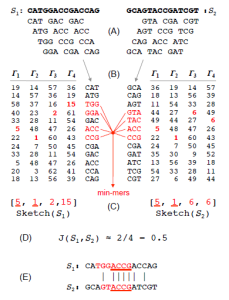
After HGAP And SPAdes Comes New PacBio Assembler - MHAP
Adam Phillippy and collaborators submitted a new paper to biorxiv -
Assembling Large Genomes with Single-Molecule Sequencing and Locality Sensitive Hashing
We report reference-grade de novo assemblies of four model organisms and the human genome from single-molecule, real-time (SMRT) sequencing. Long-read SMRT sequencing is routinely used to finish microbial genomes, but the available assembly methods have not scaled well to larger genomes. Here we introduce the MinHash Alignment Process (MHAP) for efficient overlapping of noisy, long reads using probabilistic, locality-sensitive hashing. Together with Celera Assembler, MHAP was used to reconstruct the genomes of Escherichia coli, Saccharomyces cerevisiae, Arabidopsis thaliana, Drosophila melanogaster, and human from high-coverage SMRT sequencing. The resulting assemblies include fully resolved chromosome arms and close persistent gaps in these important reference genomes, including heterochromatic and telomeric transition sequences. For D. melanogaster, MHAP achieved a 600-fold speedup relative to prior methods and a cloud computing cost of a few hundred dollars. These results demonstrate that single-molecule sequencing alone can produce near- complete eukaryotic genomes at modest cost.
A few comments -
1. Primary innovation
They use MinHash sketch.
In computer science, MinHash (or the min-wise independent permutations locality sensitive hashing scheme) is a technique for quickly estimating how similar two sets are. The scheme was invented by Andrei Broder (1997),[1] and initially used in the AltaVista search engine to detect duplicate web pages and eliminate them from search results.[2] It has also been applied in large- scale clustering problems, such as clustering documents by the similarity of their sets of words.[1]
…
A large scale evaluation has been conducted by Google in 2006 [10] to compare the performance of Minhash and Simhash[11] algorithms. In 2007 Google reported using Simhash for duplicate detection for web crawling[12] and using Minhash and LSH for Google News personalization.[13]
Here is a figure from the paper, explaining how it works -

2. SPAdes vs MHAP comparison
Using PBcR-MHAP, microbial genomes can be completely assembled from long reads in roughly the same time required to generate incomplete assemblies from short reads. For example, PBcR-MHAP was able to accurately resolve the entire genome of E. coli K12 using 85X of SMRT reads in 4.6 CPU hours, or 20 minutes using a modern 16-core desktop computer. In comparison, the state-of-the-art39 SPAdes assembler40 required 4.1 CPU hours to assemble 85X Illumina reads from the same genome. Both short- and longread assemblies are highly accurate at the nucleotide level (>99.999%), but the short-read assembly is heavily fragmented and contains more structural errors (Supplementary Table S4, Supplementary Fig. S3). Our initial SMRT assembly does contain more single- base insertion/deletion (Indel) errors, but polishing it with Quiver (requiring an additional 6.6 CPU hours) resulted in the lowest number of consensus errors of all assemblies (11 vs. 96 for SPAdes).
3. Assembly cost
Exponentially lower costs have democratized DNA sequencing, but assembling a large genome still requires substantial computing resources. Cloud computing services offer an alternative for researchers that lack access to institutional computing resources. However, the cost of assembling long-read data using cloud computing has been prohibitive. For example, using Amazon Web Services (AWS), the estimated cost to generate the D. melanogaster PBcR-BLASR assembly is over $100,000 at current rates, an order of magnitude higher than the sequencing cost. With MHAP, this cost is drastically reduced to under $300. To expand access to the PBcR-MHAP assembly pipeline, we have provided a free public AWS image as well as supporting documentation for non-expert users that reproduces the D. melanogaster assembly presented here in less than 10 hours using AWS. Allocating additional compute nodes, which would marginally increase costs, could further reduce assembly time. For E. coli, the total cost of PBcR-MHAP assembly and Quiver polishing is currently less than $2. With MHAP, assembly costs are now a small fraction of the sequencing cost for most genomes, making long-read sequencing and assembly more widely accessible.
4. Overall assessment
a) The introduction of MinHash sketch in assembly is very innovative. Also, it is very helpful that they gave full demonstration of their assembly technique for small and large genomes.
b) Aligner comparison -
In addition to speed, MHAP is a highly sensitive overlapper. We evaluated the sensitivity and specificity of MHAP versus BLASR32, the only other aligner currently capable of overlapping SMRT reads. BWA-MEM, SNAP, and RazerS were also evaluated, but their current versions were unable to reliably detect noisy overlaps (Supplementary Note 2).
Not sure, why they overlooped DALIGN. Also, BWA-MEM is tuned to near perfect alignment (k=19) and a small change in parameter will give what they are looking for. So, “their current versions were unable to reliably detect noisy overlaps” can be easily and painlessly corrected by sending a quick email to Heng Li.
c) The cost section is somewhat sloppy and is probably written for marketing department of PacBio, not serious audience. Why is cloud cost of E. coli given with Quiver and Drosophila without Quiver? Also, what can one project from $300 for Drosophila to the cloud cost of assembling human-sized genome using the same method? Does it grow as O(N) or O(N^2) with respect to size? We do not need exact numbers, but the order of growth of assembly time with genome size is something any user will look for.
Edit. A comment from @aphillippy

d) With regard to the general field of bioinformatics, it is indeed great news that assembling complete genomes, which is one of the long-standing problems, is going to be solved satisfactorily. That means bioinformaticians will have to rethink their strategy for future -